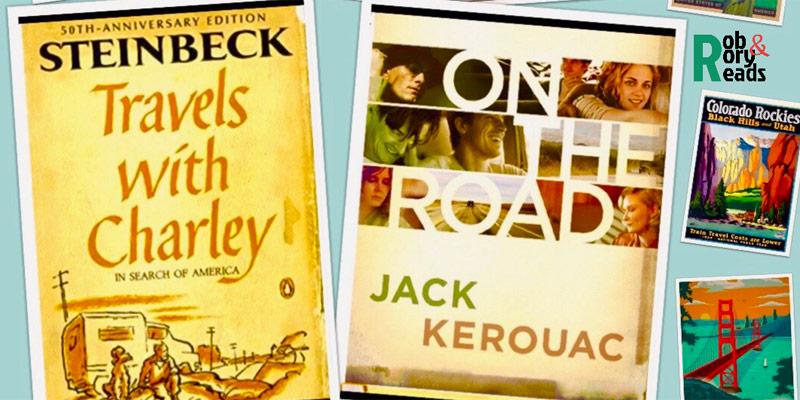In a year without travel, Steinbeck and Kerouac take us on a road trip of self-discovery

Our ability to travel was severely restricted last year, but that is not to say we cannot experience the world from the comforts of our own homes. As aphorist Mason Cooley once quipped, “Reading gives us someplace to go when we have to stay where we are.”
We turned to two classics: “Travels with Charley in Search of America” (1962, Penguin Classics), John Steinbeck’s memoir of his 3-month road trip across the United States and Jack Kerouac’s “On the Road” (1957, Penguin Modern Classics).
In Steinbeck's memoir, he drove “Rocinante,” a custom-made pick-up truck from his home on Long Island, New York, making his way north to Maine, then west to Washington State, and south to California before heading eastward again through Nevada, Colorado, Texas, and Louisiana.
Accompanied by a French poodle named Charley, who often steals the show with his amusing antics, Steinbeck’s road-trip allowed him to develop a keen insight into the human condition and write a wry critique of many of humankind’s meanderings and pointless extravagances.
Steinbeck, awarded the Pulitzer Prize for Fiction in 1940 and the Nobel Prize in Literature in 1960, is best known for his novels “The Grapes of Wrath” and “Of Mice and Men," where he explored the deep emotional and psychological toll brought about by America’s Great Depression in the 1930s and the westward migration from the Dustbowl to California.
But in this memoir, which will soon celebrate the 60th anniversary of its publication, he departs from the melancholy that characterizes what literary experts refer to as “vintage Steinbeck.”
“Travels with Charley” is playful, often irreverent, and always entertaining. Steinbeck and Charley become the archetypal odd couple, like Jack Lemmon and Walter Matthau’s “Grumpy Old Men” but a lot less grumpy. As they revel in the grandeur of the United States, they bemoan the gradual loss of its cultural diversity.
In his signature, sardonic style, Steinbeck highlights the paradox that technology makes life easier and more predictable but also less interesting. A Filipino makes an important cameo in the book, driving home the crucial point that immigrants helped build the United States into the country it is today.
If “Travels with Charley” provides a sweeping vista of the United States using a long panoramic tracking shot, then Jack Kerouac’s “On the Road” (1957, Penguin Modern Classics) is its indie documentary equivalent, the quivering hand-held video camera following its colorful cast of characters as they go through their paces.
Its narrative structure is experimental and, much like the bebop jazz prominent at that time, is characterized by improvisation and sudden changes in mood. This may make “On the Road” a little difficult to read as it does not hew to traditional storytelling techniques.
But as we look forward to the centenary of Kerouac’s birth next year, we have a wonderful opportunity to experience this narrative experimentation that transformed it into a celebrated modern classic. We can get to discover why icons such as Bob Dylan said the novel “changed my life like it changed everyone else’s.”
In the novel, Kerouac relates a fictional account of Sal Paradise’s trek through America, first as a hitchhiker, then eventually driving cross-country in a beat-up Hudson with his hero Dean Moriarty. Along the way, Sal the writer-academic experiences up close the life of people on the fringes of society who defined the 1950s Beat Generation.
“On the Road” is jagged with frantic energy. Kerouac casts a raw, glaring, and unapologetic spotlight on an America rarely seen by the casual observer. The novel is a counter-culture’s reaction to being betrayed by the Establishment. It is a manifesto extolling spontaneity and the youth’s exuberance and feeling of near-invincibility. Most importantly, it is an in-your-face examination of the fractured psyche of a generation which witnessed the horrors of war.
These modern literary classics can be educational for everyone. They take us on eye-opening road trips through a country during defining moments in its history. Aside from enjoying the scenic drive across America’s myriad landscapes, we learn that egregious societal errors such as bigotry, greed, or even apathy not only damage the social fabric but severely set back a country’s development. We develop a better appreciation of how a country’s inherent but often ignored cultural diversity can be a powerful source of national identity.
We also discover that travel can change us for the better if we let it, and that a trip is about much more than just the destination, the selfies, and the souvenirs. As Steinbeck succinctly put it, “A journey is a person in itself; no two are alike… We find after years of struggle that we do not take a trip; the trip takes us.”
But until such time when we can all safely travel again, we can take comfort in the fact that reading books allows us to virtually roam the world, weather our seclusion, deepen our empathy, appreciate other cultures and peoples, and broaden our worldview. — LA, GMA News
About the authors: Rory J. Bolivar is a registered microbiologist, educator, and writer. Robespierre L. Bolivar is the recipient of the Gawad Mabini, one of the highest Presidential honors bestowed upon Filipino diplomats. Follow them on Instagram @robroryreads and visit their website at https://robroryreads.wixsite.com/bookreviews



